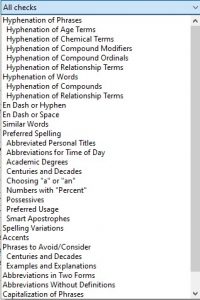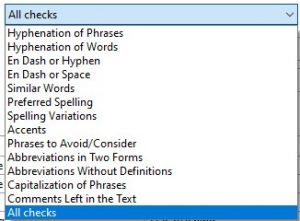
Many editors swear by PerfectIt as a must-have tool to help produce consistent and style-adhering texts. A new style sheet to be released on 10 August, developed in conjunction with The Chicago Manual of Style (CMOS), takes PerfectIt to a new level 一 great news for those who use CMOS and possibly also for others. If you already use PerfectIt (for which IPEd members get a discount 一 login required) and subscribe to CMOS Online, it won’t cost you anything more.
Background on PerfectIt
PerfectIt is an add-on that runs within Microsoft Word. At its most basic, it is a consistency checker: it will find if you’ve used ‘square-dance’ on page four and ‘square dance’ on page 178, or ‘PerfectIt’ and ‘Perfectit’, or spelled ‘Murray–Darling Basin’ sometimes with an en dash and sometimes with a hyphen.
What PerfectIt does is present you with instances of inconsistency. You then choose which is correct one for each instance. Sometimes, you will always want the same alternative; for example, ‘Murray–Darling Basin’ with the en dash is correct if you’re following the Australian Government Style Manual. At other times, which alternative you want depends on context, for example, a ‘long-term’ plan, versus plan for the ‘long term’.
Delving deeper into PerfectIt’s options, you can also set preferences for a range of styles, including heading capitalisation style, numbers as digits or words, abbreviations not given or given more than once, to name just a few. When you set a preference, instances of use that don’t follow your preference are presented for you to check.
A whole suite of freely available style sheets already have preferences set for you. These range from simple spelling preferences (Australian, Canadian, UK and US) to styles for particular organisations or circumstances (such as Australian Government, World Health Organization, American Legal).
For many users (but sadly not those using a Mac) the icing on the cake is being able to customise the style sheets and create your own 一 I tend to do this for each of my regular clients as they all have their own particular styles.
This month, PerfectIt is releasing an update (PerfectIt 5) with a new style sheet for The Chicago Manual of Style that integrates the online manual with PerfectIt.
The CMOS style sheet
I was lucky enough to review the beta version of PerfectIt 5 just as I was editing a book using CMOS style, which is a change from my usual editing in Australian style. I have enjoyed using CMOS Online because it’s so comprehensive and has answers for just about any query. I can see why editors (not only those editing in American English) often refer to CMOS when questions of style come up. So, rather than just running the text through PerfectIt using the US spelling style, as had been my plan, I tested out the new CMOS style.
Using the new style sheet
The CMOS style sheet works in the same way as other style sheets. For example, the Hyphenation of Phrases check finds ‘energy deprived’ and ‘energy-deprived’, as you can see in Figure 1 (right).
Now, however, the explanation is accompanied by a reference to the relevant section in CMOS. Clicking that reference opens up a short paragraph from CMOS within the PerfectIt window (Figure 2, below).
![A screenshot of the Chicago Manual of Style information window in PerfectIt. The text, which has some links in red, reads: 7.85 [a red link]. Hyphenation often depends on context. When a compound modifier such as high-profile or book-length precedes a noun, a hyphen usually lends clarity. With the exception of proper nouns like United States and compounds formed by an ly adverb plus an adjective (see 7.86 [a red link]), it is never incorrect to hyphenate adjectival compounds before a noun. After a noun, however, hyphenation is usually unnecessary, even for adjectival compounds hyphenated in Merriam-Webster (e.g., ‘a well-read student’; but ‘the student is well read’). For many more examples, see the hyphenation guide [a red link].](https://www.iped-editors.org/wp-content/uploads/2021/07/Fig2-300x268.jpg)
Figure 2. CMOS information about hyphenation

Figure 1. Hyphenation of phrases message
As you can see, you still need to make decisions. For example, PerfectIt found contractions in my text and gave its standard suggestion: ‘In formal documents, consider spelling contractions in full.’ The linked CMOS information, however, began: ‘Most types of writing benefit from the use of contractions.’
As with all the issues flagged by PerfectIt, the decision remains with you as the editor, but this new style sheet gives you lots of information to help you decide.
Other features
The CMOS style sheet is more detailed than other PerfectIt style sheets. Figure 3 shows the checks performed (and that you can customise) in CMOS against those performed in the current Australian Government style. The bottom two lines in the Australian Governments style list 一 Comments Left in Text and All checks 一 also occur in CMOS but were out of sight in the screengrab.
CMOS checks

Figure 3a. Comparison of checks in CMOS
Australian Government checks

Figure 3.b Comparison of checks in Australian Government styles
The Australian Government style does have some entries relevant to the new CMOS subheadings, but scanning through I can see that they are much less extensive. For example, a few possessives are listed within Preferred Spelling (Achilles heel [no apostrophe], Burns’s, Dickens’s), but CMOS lists dozens (from Aariz’s to Zeus’s) via Achilles’ heel (an exception to their general rule and also different to the Australian use) and Jesus’s (not an exception).
Inevitably, CMOS has many entries particularly relevant to American topics, such as names of court cases and US newspapers (italics), names of judges, justices and presidents (capitals), names of well-known Americans (spelling), and it uses spellings from the US Merriam-Webster Dictionary. While that is less useful to editors working in Australian English, it still picks up many usages that can be corrected or improved. The preferences in Preferred Usage and Phrases to Avoid/Consider cover points discussed in CMOS Online’s section 5.250, Good usage versus common usage (login required). Table 1 shows a small selection of the various types of misuses or poor uses that will be checked, including many corrections that editors love to find.
Table 1. A selection of ‘good usage’ points the PerfectIt CMOS style sheet will check
| If it finds this: | It will suggest this: |
| alongside of | alongside |
| after having failed | after failing |
| could care less | couldn’t care less |
| between you and I | between you and me |
| are predominate | are predominant (distinguishing between the adjective (predominant) and the verb (predominate) |
| are comprised of | consist of (or the alternative ‘are composed of’) |
| hones in on | homes in on |
| strain credulity | strain credibility |
| begs the question | The prompt is: ‘Avoid using “begs the question” simply to mean prompts, invites, evades or ignores a question.’ |
| and/or | The prompt is: ‘The term “and/or” can often be replaced by either “and” or “or” with no loss of meaning.’ |
The CMOS style sheet also contains some wildcard searches that will find time (am and pm) and date (AD, BC) formats, among other things. Figure 4 shows a message I particularly liked 一 it’s a change I would have made anyway, but coming up in the PerfectIt check means I won’t miss it.
![A screenshot of the Chicago Manual of Style information window in PerfectIt. The text, which has some links in red, reads: 7.59 [a red link]. A word or phrase preceded by so-called need not be enclosed in quotation marks. The expression itself indicates irony or doubt (e.g., ‘So-called child protection sometimes fails to protect’). If, however, it is necessary to call attention to only one part of a phrase, quote marks may be helpful (e.g., ‘These days, so-called “running” shoes are more likely to be seen on the feet of walkers’ [where; running’ would appear in double quotation marks except, as in the example, as a quote within a quote]).](https://www.iped-editors.org/wp-content/uploads/2021/07/Fig4-300x191.jpg)
Figure 4. CMOS explanation for not using quotes after ‘so-called’
It’s not the whole CMOS style manual
While the CMOS style sheet for PerfectIt offers many features, it is intended to supplement The Chicago Manual of Style, not replace it. To quote the style sheet: ‘It’s designed to help you apply the style and learn how it works, with targeted suggestions and detailed explanations that quote directly from the Manual. It is not intended to be exhaustive.’
This is true in two ways. Many CMOS rules go into much more depth and nuance than can be converted into PerfectIt-style checks of words and phrases (for example, section 13.7 covers permissible changes to punctuation, capitalisation and spelling in quotations). And the whole topic of referencing is also beyond the scope of PerfectIt for now 一 but they are working towards adding referencing and citations in a future update.
Also, some checks that PerfectIt could perform are, at least in the beta version I have, not set to be checked by default. For example, CMOS strongly recommends using serial commas, but this test (in Settings) was set to ‘Do not check’. It’s an easy matter to turn it on, but that does suggest you should browse through the settings to make sure all the checks you want to use are turned on.
Should you be excited?
If you edit according to CMOS, you’ll get a lot out of using the CMOS style sheet in PerfectIt. I’m wondering about using it myself even for non-CMOS projects, just to benefit from some of its new features. CMOS style is customisable (on PCs, not Macs), and you can choose certain checks and not use others that may not be relevant. You could even copy some of the checks from the CMOS style sheet and add them to the style sheet you usually use.
Whether you’re a CMOS user or not, the new style sheet is definitely worth investigating. Compared to other style sheets, it offers a new level of style and consistency checking that will help improve your documents.
Margie Beilharz is an editor, writer and science communicator based in Melbourne.
